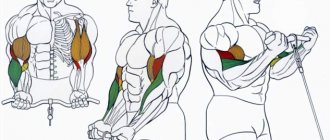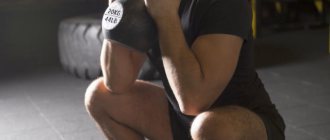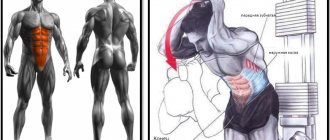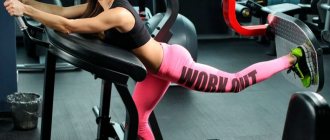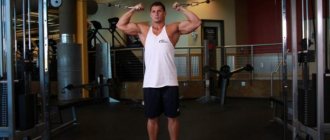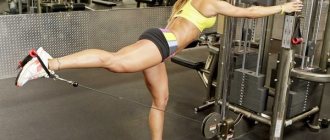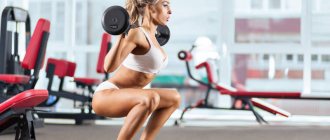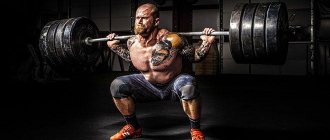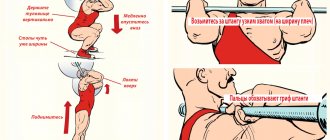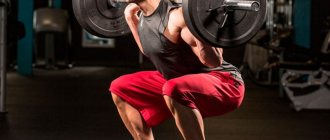Everyone is familiar with classic barbell squats as a means of achieving beautiful buttocks. There are also other, no less interesting variations, such as crossover squats. This is an excellent option for unprepared athletes whose fragile shoulders and back are not yet ready to hold a barbell, as well as for athletes who are contraindicated for compression loads on the spine. Let's look at the benefits of crossover squats and whether they have any disadvantages.
Variety in popping: crossover squats
It’s clear that absolutely all girls want to have the elastic, fit Madame Siju. In addition to the necessary classic barbell squats and lunges, crossover squats with a lower block are an effective exercise.
It is worth including such exercises at least for the comprehensiveness of the muscles, because in this type of squats, the load is distributed throughout the body differently and the peak load occurs at the moment of the culminating muscle contraction.
The exercise is, frankly speaking, super unpopular, perhaps because of its apparent simplicity. Although squats with wide legs at the lower block of the crossover are not at all so elementary, because... It is important to find “your” position and your weight, in which the back will not steal the load from the buttocks.
Crossover mixing with different body angles
Vertical body position
This version of the initial position is used both for mixing with the upper, middle and lower positions of the handles. The basic mixing technique does not change. The almost complete absence of tilt makes the shoulders more stable and their range of motion more natural. This option is indicated for athletes with shoulder injuries and anterior deltoid overloaded from the bench press.
Slight forward lean
A slight inclination allows you to deepen the stretch of the pectoral muscles and work them out more efficiently with lighter weights. Used in training beginners, legs can be placed either in straddle or in parallel
An important condition is not to change the angle of the body.
Tilt forward 90 degrees
This is an extreme option used in bodybuilding. It gives maximum stretch to the pectoralis major muscle, but involves the entire upper body, and is quite risky for the shoulder joint. This option is not used in fitness, and is not recommended for independent development due to the risk of injury.
Technique
Crossover squat technique with a lower block:
Feet wider than shoulders, shoulders lowered and relaxed. In a half-squat and WITH A STRAIGHT BACK (you can’t bend forward - you can injure your spine), take the handle (choose any one, it’s not important, but it will be easier with a straight line).
Types of crossover handles
REMEMBER that the exercise begins from the second you approach the apparatus, i.e. We don’t bend our backs under any circumstances!
Pay attention to the grip – classic, straight. We spread our shoulders, connect the shoulder blades, transfer the weight to the heels, as if resting on them, get up and walk away.
We place our feet wider than our shoulders, with our toes pointed to the sides for the correct angle of application of the load, as in a classic squat .
Advice: the abs should be tense IN ALL EXERCISES, this will allow you to “give” part of the load to the abs, and also train yourself to keep your stomach pulled in.
We squat with a straight back with practically motionless knees, (sorry for the directness) “kicking off” our butt and resting on our heels. When lifting, a little . Throughout the entire exercise, you need to tighten your gluteal muscles , thereby creating artificial tension in them for greater effect.
If you don't put your weight on your heels and lean back, you won't get the desired emphasis on the gluteal muscles, but will shift it to the back muscles.
If you not pulled back or carried forward, then you are doing it correctly. If done correctly, you will feel exactly your butt.
We come forward and squat with a straight back. The depth of the squat is maximum, although again, this is a deeply individual thing.
When squatting, we move our legs forward a little and move our glutes back. From this position powerful! by force of the hips and buttocks ! we return to the starting position.
Try different squats: floor, parallel, etc. and check which one gives the maximum impact to the buttocks. For example, in this exercise, I personally feel the buttocks best when squatting just below parallel.
The exercise is NOT FOR BEGINNERS, because... you need already strengthened back muscles. We advise you to gradually add working weight and not rush too much. If you have back problems, take less weight and do 15-20 repetitions. If the lower back muscles are strengthened, then on the contrary, we increase the weight and do up to 8 repetitions.
Perform this exercise as part of a set of exercises for the gluteal muscles once a week with maximum intensity, at the end of your buttock workout.
Squat mistakes
Let's look at common shortcomings in the technique that interfere with the development of the athlete and reduce the effectiveness of the exercise:
- Bringing the hips inward as you lower. Make sure your knees remain in line with your feet. Otherwise, the dangerous load on the knee joints increases.
- Incorrect breathing. You should exhale with effort, that is, when rising from the lowest point. Errors in this nuance affect the effectiveness of the squat.
- "Throwing" the body down. Typically for beginner athletes who have undeveloped leg muscles. Raising and lowering must be uniform and controlled.
- "Rounding" of the back. A dangerous mistake, especially when performing squats with additional weights. The spine should be kept straight and the lower back arched.
- Strong forward lean. During a squat, a natural tilt of the body appears. You should not “pillow” your chest down, as this will lead to loss of balance.
Ignoring mistakes can cause pain in the knee joints, lower back and spine. Therefore, you need to work out the basic technique. If you plan to train with heavy weights, we recommend that you learn squats with an instructor who will be able to notice shortcomings in time and correct them.
Crossover squats: technique of performing a squat in the lower block
Everyone is familiar with classic barbell squats as a means of achieving beautiful buttocks. There are also other, no less interesting variations, such as crossover squats. This is an excellent option for unprepared athletes whose fragile shoulders and back are not yet ready to hold a barbell, as well as for athletes who are contraindicated for compression loads on the spine. Let's look at the benefits of crossover squats and whether they have any disadvantages.
Purpose of the block simulator
A power crossover is more suitable for training for relief rather than for weight loss. It does an excellent job of warming up the muscles, is good for pumping and isolating finishing work of the target muscles. On this multifunctional simulator, it is possible to work out the force of the blow, but on the condition that it has already been delivered. This leads to advice - beginners should not start training their punch on this power machine.
In the crossover, exercises are performed for the following muscle groups:
- Biceps and triceps;
- Deltoid muscles;
- Breasts and abs;
- Buttocks and legs (inner, outer and back surfaces).
The benefits and disadvantages of the crossover squat
Benefits of the exercise:
- Allows you to work the gluteal muscles and improve their shape without putting stress on the spine and knee joints.
- When performing a block squat, the load on the buttocks increases, and the load on the back and abdominal muscles decreases. Thus, the stabilizers work less than in the version with a barbell on the shoulders.
- Allows you to develop general endurance of the muscles and the entire body as a whole.
- With this exercise, you can remove excess weight by performing an entire endurance workout with a high number of repetitions in each set.
Flaws:
- Not suitable for developing strength and increasing muscle size. In this option, it will not be possible to work with a lot of weight, since the weights on the block will outweigh, and this will cause the technique to suffer and reduce the effect of the exercise.
- The exercise is often performed incorrectly, confused with the pull-down of the lower block. For many people, their back falls forward too much, literally bending their torso. This is not worth doing. Start working with light weights and practice proper technique.
What muscles work
- The main load goes to the target muscles, namely the gluteal muscles. The hamstrings are also involved in the work.
- The stabilizing function is performed by the spinal extensors, abdominal muscles, anterior deltoids and quadriceps.
If you do the exercise incorrectly , other muscles may also come into play. For example, bending forward too much puts a lot of stress on the shins, but this is an extremely negative effect, especially for women, and it indicates incorrect technique for performing the exercise.
Technique for performing a squat from the lower block
- Install the clamp on the working weight in the crossover, attach a straight handle to the lower block. By the way, you can also work with rope.
- Grab the handle with both hands closer to the edges, straighten up and move a short distance away from the block.
- Place your feet slightly wider than your pelvis, with your toes slightly pointed apart.
- Lean your whole body back slightly, but do not arch your lower back. The resistance of the rope will prevent you from falling backwards, just find a support point. It is important to transfer your body weight to your heels. Keep your arms straight throughout the approach.
- As you inhale, move your pelvis back, as with regular squats, only transfer more weight to your heels, do not let the block pull your torso. In this case, the body is kept as upright as possible. There is no need to straighten your torso perpendicular to the floor, but you should not bend almost parallel to the floor either.
- The pelvis can be lowered to the level of the knees, or a little lower. The main thing is not to round the lower back.
- Exhale, push your heels off the floor and straighten your torso, returning to the starting position. At the top point of the amplitude, squeeze your buttocks, increasing muscle contraction, as if you were twisting your tailbone “under you.”
- Don't relax your abs throughout the entire approach. At the top, maintain a straight line with your body slightly tilted back.
Description of the exercise
Typically performed with dumbbells or kettlebells. The more you turn your toes and knees, the more stress will be placed on the inner thigh. Do not bend your back too much. Mainly the legs should work. For more flexible and advanced feet, you can place them on stands. This will allow you to go even lower.
Main features
1. The option with one dumbbell is the most common. Since this option does not require any special devices. However, with this option, not only the legs work, but also the back. That is, the load goes to the back too. And doing this exercise with heavy weight is inconvenient. Simply because it is inconvenient to hold a large dumbbell.
2. Another option is when a special pin with handles is used instead of a dumbbell. Pancakes are put on this pin, and you hold on to the handles. The essence is the same as with dumbbells, however, you can hang quite large weights and it will be convenient. Personally, I weighed up to 180 kg.
3. And the third option is when the weight is hung on the belt through a special belt and chain (or rope). With this option, the back is not loaded, and only the legs work. The hands usually rest on the shoulders. This option is used quite rarely, since few people want to bother with it. But it is indispensable when you only want to train your legs.
4. I recommend using footrests. This will increase the amplitude. But for this you still need to have a certain flexibility in the hip joints.
5. Feet, as a rule, are placed slightly wider than shoulders and toes are turned to the side at an angle of 45 degrees. This is done in order to engage the inner thigh.
Training recommendations for women and men
- Girls can freely use the exercise in training, but they should not perform it more than twice a week.
- For cable squats, do not use a large weight, otherwise it will be impossible to perform the exercise correctly.
- When performing the exercise, concentrate on working your buttocks, always push your heels off the floor, thus allowing you to push your pelvis up through your buttocks.
- Perform 15-25 repetitions for 3-4 sets. Select the weight so that by the last repetitions you feel a burning sensation in the gluteal muscles, and not in the lower back.
- Do not perform jerking or swinging additional movements.
- The exercise can be combined with other basic exercises for the legs and buttocks, for example, leg press, hack squats. Only in this case, crossover squats should be performed after them. It can also be supplemented with isolating exercises - bending and straightening the legs in a machine, hyperextension, only after squats.
- For men, this exercise will be relevant if compression load on the spine is prohibited. The disadvantage of the exercise is that it cannot be performed with heavy weight. The optimal number of repetitions for the block: 14-20 for 3-4 approaches. To develop strength or increase mass, it is better to replace the exercise with a leg press.
Sumo squats at the bottom block. What, why and why?
We are for a variety of workouts! And we don't like that people in the gym use the same exercises. For example, don’t feed girls bread, let them do squats with a barbell, lunges, glute bridges and Romanian deadlifts. Of course, these are great exercises, but doing them on a regular basis, especially if they don’t produce results, is stupid. In our previous articles, we looked at unusual leg exercises, and today we will introduce you to a variation of one classic exercise, the name of which is sumo squats at the lower block. Go!
Note: For better assimilation of the material, all further narration will be divided into subchapters.
Muscle atlas
The exercise belongs to the class of basic/conditionally basic with the type of force push (push) and is aimed at working out the lower body.
The muscle ensemble includes the following units:
- targeted – quadriceps, buttocks;
- synergists – gluteus maximus, adductor magnus, soleus;
- dynamic stabilizers - hamstrings, calf;
- stabilizers - spinal extensors;
- antagonist-stabilizers – rectus and oblique abdominal muscles.
A complete muscle atlas looks like this.
Advantages
By performing the sumo squat exercise at the bottom block, you can expect to receive the following benefits:
- increasing the volume of the buttocks;
- development of leg muscle strength;
- development of abdominal and core muscle strength;
- tightening the inner thigh;
- strengthening the stabilizer muscles;
- possibility of execution for back problems (for example, protrusions, hernias).
